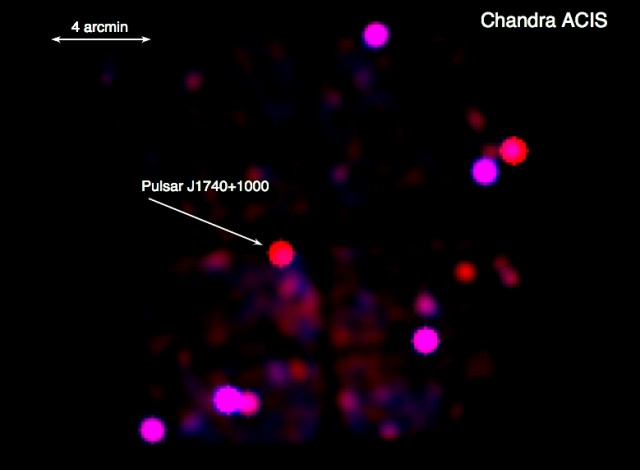
Neutron stars provide some of the most extreme environments in the Universe. Massive as ordinary stars but smaller than a city, they are more dense than atomic nuclei. Most neutron stars we've identified are pulsars, which send out beams of intense light due to their rapid rotation and strong magnetic fields. Pulsars in general appear to lack atmospheres, but a few anomalous neutron stars have been found. These show signs of absorption, which suggests some atmosphere, and lack strong pulsar effects; a few lack strong magnetic fields as well.
To make matters more complicated, researchers have now found that the pulsar PSR J1740+1000 appears to combine the features of ordinary pulsars—and the anomalous ones as well. As described in a Nature paper by Oleg Kargaltsev, Martin Durant, Zdenka Misanovic, and George G. Pavlov, this neutron star is a normal radio pulsar like others in many ways. However, it exhibits clear absorption lines in its X-ray spectrum. The authors suggest that the absorption could be due to a structure similar to Earth's van Allen radiation belts.
The light emitted by pulsars is the product of both thermal emission from their surfaces and non-thermal emission from charged particles accelerated by the magnetic field. Neutron stars exhibit surface temperatures of hundreds of thousands to millions of Kelvins (105–106 K), far hotter than a typical star that is powered by fusion.
Anomalous neutron stars, on the other hand, may not emit light in the radio frequencies at all; some appear to lack the charged particles that normally produce the strong beams of light. They also possess absorption features, which are formed when specific elements or molecules absorb photons emitted by the star. Typically, these were interpreted to be related to their unusual characteristics, such as (relatively) low magnetic fields—the different environment near these stars may allow for an atmosphere, for example.
All of this explains why PSR J1740+1000 appears so strange. Most of its characteristics are typical of rotation-powered radio pulsars, but observations using the Chandra and XMM-Newton (X-ray Multi-Mirror) telescopes revealed unusual features. These anomalies didn't correspond to the thermal and non-thermal emissions of ordinary pulsars, so they could be the result of absorption or scattering of light by particles (electrons or ions) near the neutron star.
The researchers considered several possibilities, and concluded the most likely culprits for the missing energy were particles high in the pulsar's magnetosphere. This (completely hypothetical) structure is analogous to Earth's van Allen radiation belts, toroidal regions where the planet's magnetic field concentrates charged particles from the solar wind. The astronomers proposed that other pulsars may also have such a belt, but that the absorption is small enough that it hasn't been spotted.
They also identified three other pulsars that have spectral features similar to those of PSR J1740+1000 could also be explained using the same absorption mechanism.
If these van Allen-like structures exist in other—maybe most—pulsars, then more observations should spot them. Since absorption can arise from other sources (atoms between the pulsar and Earth, for example), the researchers argued that we may already have seen it, but ascribed it to these other factors.
Absorption by charged particles in the magnetosphere may help explain many anomalous features we've seen in other systems, and help us understand pulsars and anomalous neutron stars as two outcomes of a single system.
Science, 2012. DOI: 10.1126/science.1221378 (About DOIs).
reader comments
8